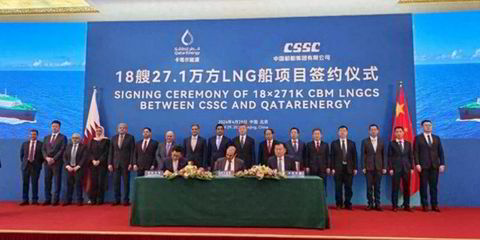The risks to crew of using ammonia as a maritime fuel can be kept to a tolerable level if a series of measures are developed, a collaborative report has found.
The two-year study into the design and operation of ammonia-fuelled ships was led by Lloyd’s Register Maritime Decarbonisation Hub and the Maersk Mc-Kinney Moller Center for Zero Carbon Shipping, with input from shipowners, shipbuilders and fuel producers.
Ammonia holds out hope as a promising alternative fuel for ships, as it can be combusted with almost no CO2 emissions. However, it is a highly toxic chemical that does emit the potent greenhouse gas nitrous oxide, which needs to be managed.
The report set out a list of high-priority technical findings and recommendations, plus measures addressing human factors, to enhance safety on ammonia-fuelled container ships, tankers and bulk carriers.
Recommendations include:
- Lower storage temperatures to reduce the safety risk.
- Divide the fuel preparation room into two or more separate spaces containing different groups of equipment.
- Minimise, monitor and control access to and time spent in spaces containing ammonia equipment.
- Adequately separate ventilation outlets from spaces containing ammonia equipment from areas accessed by the crew.
- Install multiple sensors of different types to detect leaks.
Other findings include fitting secondary containment mechanisms, such as double-walled piping, for ammonia-related equipment outside of already-restricted areas; installing ventilated gas-tight enclosures around gas valve units in engine rooms; and subjecting the fuel system to rapid, reliable manual and automated shutdown in the event of a leak.
Human factors included specific training to prepare crew for operation and maintenance, and updating safe work practices and standard procedures through systematic change management programmes.
Personal protective equipment and safety management procedures for an emergency response also need to be developed, said the report, Recommendations for Design and Operation of Ammonia-Fuelled Vessels based on Multi-disciplinary Risk Analysis.
“We conclude that the risks to crew of using ammonia as an alternative maritime fuel can be kept to a tolerable level” if recommended technical and human measures are undertaken, it concluded.
The report said it is safer to store ammonia in a non-pressurised condition at -33C, as a leak will form a pool that will evaporate relatively slowly as it heats up. In a warm, pressurised state, leaked ammonia evaporates immediately as pressure is released, quickly forming a gas cloud.
Fuel preparation and reliquefaction equipment should be split across up to three separate smaller spaces — one containing the fuel supply system for the main engine, another the supply system for the auxiliary engines and a third room for reliquefaction units.
The report said ventilation is only partly effective at preventing ammonia concentrations from reaching levels that may be fatal, and recommended crew accommodation spaces should be protected from ingress as far as possible.
Depending on storage conditions and ammonia tank location, shutting down the ventilation for crew accommodation should be made possible in the event of a leak, it said.

Martin Eriksen, head of safety leadership at the Maersk Mc-Kinney Moller Center, told TradeWinds the study took a deep safety focus on how humans interact with technologies.
Dr Andy Franks, senior decarbonisation risks specialist at the Lloyd’s Register decarbonisation hub, said some of the processes chime with current good practices, but new ways of operating have emerged — particularly multiple separation.
He said it helped immensely to have shipbuilder Mitsubishi Heavy Industries involved with engineering design aspects, NYK Line on shipboard operations and TotalEnergies from a fuel perspective.
Eriksen said understanding the technical risks and human factors of ammonia fuelling is still at an early stage, but the strength of the report lies in how those factors interact.
“Those two things intersect. For the industry to be able to transition to ammonia as a fuel, you need to do both with the same rigour,” he said.
“If you look at it from a technical and engineering perspective: what safeguards and design choices do you take to prepare for operation? But we have humans intersecting with that technology and we place reliability on them to respond to events when situations evolve.”
Franks agreed that a proportionate amount of diligence and care needs to go into the design and preparation of vessels as it does with training people.
“I would hate people to take away from this report any sense of complacency that ‘we can get in this ballpark, tick, job done’. Yes, we have been using ammonia for a long time. Yes, we have been moving it as a cargo, but this is a new ballgame in many respects and ammonia needs to be treated with a great deal of respect,” he said.
He suggested that experience in the offshore shipping business could possibly provide ways of looking at different approaches to escape, evacuation and rescue operations in the case of accidents.
Recommendations for Design and Operation of Ammonia-Fuelled Vessels based on Multi-disciplinary Risk Analysis used quantitative risk assessment (QRA) analysis, rather than a qualitative approach.
QRA is a powerful data-driven method that allows users to assess risk in a granular manner, the joint study partners said, and has been able to identify vessel design and operational measures that would reduce ammonia risks to as low as reasonably practical.






